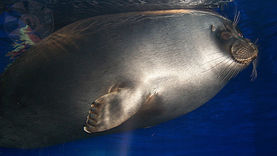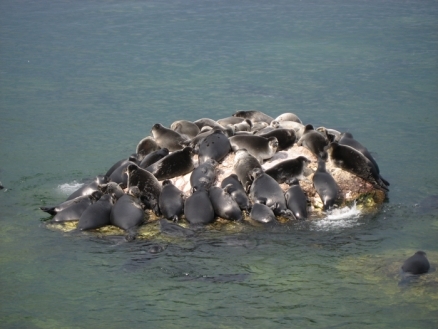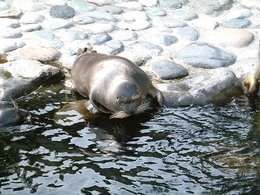Baikal seal
The Baikal seal (scientific name: Pusa sibirica) is one of nineteen species of marine mammals in the family of true seals. Together with the families of eared seals and walruses, True seals form the group of marine mammals known as pinnipeds.
Baikal seals are endemic to Lake Baikal in Southern Siberia, Russia (near the Mongolian border) and are found only this lake and connecting rivers.
Contents
Physical Description
Baikal seals are one of the smallest seals. Adults grow to a length of about 1.3 metres. The adult coat is dark, with a silvery gray back and lighter yellowish gray front. Some individuals also have a spotted coat, but these are rare. Their fur is dense, and males are generally somewhat larger than females. Baikal seals have stronger and larger forelimbs than many other species of seals. The head is rounded and the body spindle-shaped. The dental formula is 2/3 1/1 5/5 = 34.
Reproduction
| Conservation Status |
|
Scientific Classification Kingdom: Animalia (Animals) |
Baikal seals have a polygynous mating system, with mating occurring in the water at around the time the last pup is weaned, usually in May. Females experience a short period of delayed implantation. Gestation lasts for about nine months and the pups are born on lake ice from mid-February to March. Usually only one pup is born, but twins are not uncommon. If there are twins, both of them usually survive to weaning and then stay together for some time. At birth, pups weigh around three to four kg and measure from 65 to 70 centimetres in length. They are covered with a long, white, woolly coat that lasts for the first 6 weeks and then is shed and replaced by an adult coat.
Females tend to reach sexual maturity at three to six years of age and males at four to seven years of age. Females can breed until they are about 30 years of age. About 88% of sexually mature females have pups each year. Mothers nurse their pups for eight to ten weeks, except in the southern part of the lake where the ice breaks up earlier. Pups in the south are weaned prematurely and are thus smaller upon maturity.
Behavior
During the winter, these seals are solitary. They usually moult on ice in late spring, but if the ice has already melted they finish their molt on shore. In 1990 and 1991, a number of juvenile seals were radio tagged. This tagging revealed that the seals traveled between 400 and 1600 km around the lake from September to May.
During the winter months, when the lake is primarily covered with ice, Baikal seals stay near breathing holes they have made. They keep these holes open by scraping them with their strong claws. Some seals may also use their head, teeth, and rear flippers. Adult seals have one breathing hole, but this hole has many auxiliary openings. Immature seals only use one breathing hole.
 Baikal seal swimming, Siberia. Baikal seals are most widely dispersed during the winter months. Mature males scatter throughout the lake. Mature females are usually found on the east shore. Male and female seals that have not yet reached sexual maturity are found on the west shore. Pregnant females remain on the ice for most of the winter.
Baikal seal swimming, Siberia. Baikal seals are most widely dispersed during the winter months. Mature males scatter throughout the lake. Mature females are usually found on the east shore. Male and female seals that have not yet reached sexual maturity are found on the west shore. Pregnant females remain on the ice for most of the winter.
At around the first of April, Baikal seals begin to congregate to feed along fresh openings where the ice has melted. In May they move to the north end of the lake and stay there until they molt, which usually occurs in late May and early June. During the summer months, Baikal seals move to the southeast corner of the lake to use the rocks and shore for hauling out. When fall returns, they again begin to move to the areas where ice is forming.
Baikal seals are solitary animals, but several seals may congregate and share access holes. They will also gather at places where the habitat is most favorable. In spring, when they feed the most, 200 to 500 animals will gather in one area. The first to come are juveniles, then adult males, and, finally, new pups and their mothers. Large groups also form on the shores in the summer.
Distribution
Baikal seals are endemic to Lake Baikal in Southern Siberia, Russia (near the Mongolian border) and are found only this lake and connecting rivers.
Habitat
The Baikal seal is the only seal that lives primarily in freshwater. It is endemic to Lake Baikal, and occasionally is found in rivers connecting to the lake. Ice conditions in the lake determine the seasonal movements and activities of these seals. In winter the lake is covered by ice that is 80 to 90 centimetres thick.
Food Habits
Baikal seals eat mainly fish in the pelagic genera Comephorus and Cottocomephorus. They also eat fish of little commercial value, such as golomyanka. These fish move to depths of 20 to 180 metres at night. Baikal seals will also eat invertebrates found in the lake. Most foraging for food occurs at twilight and night. Young seals have been observed feeding up to 100 m in depth. They have also been observed doing some short duration dives, most of which last under 10 minutes. Maximum diving time is estimated to be around 20 to 25 minutes, although some seals that are frightened can stay under two to three times longer.
Conservation Status
It is estimated that the Baikal seal population is about 80,000 to 100,000 individuals, which is about the carrying capacity of the lake. Hunters can legally take Baikal seals, even though the population of this speciels is considered in decline. Human disturbance and destruction of habitat are some major causes of this decline. Water pollution from the paper industry is another cause. In 1987-1988 approximately 5000 Baikal seals died from an infection caused by a form of Canine Distemper Virus. It is thought this virus was transmitted from dogs or other land mammals.
Economic Importance for Humans
Baikal seals are regularly taken by hunters. About 2000 to 3000 pups are killed each year for their skins. Adult seals are also killed for their meat, pelt and oil. Baikal seals eat fish that are important to fishermen in Lake Baikal. Fish of the genus Comephorus make up a large part of their diet. These fish are commercially important and, as a result, these seals do some harm to the fishing industry.
Further Reading
- Pusa sibirica (Gmelin, 1788) , Encyclopedia of Life (accessed May 10. 2010)
- Pusa sibirica, Harrold, A., 2002, Animal Diversity Web (accessed May 10. 2010)
- Baikal seal, Seal Conservation Society (accessed May 10. 2010)
- Pusa sibiric IUCN Red List of Threatened Species (accessed May 10. 2010)
- The Pinnipeds: Seals, Sea Lions, and Walruses, Marianne Riedman, University of California Press, 1991 ISBN: 0520064984
- Encyclopedia of Marine Mammals, Bernd Wursig, Academic Press, 2002 ISBN: 0125513402
- Marine Mammal Research: Conservation beyond Crisis, edited by John E. Reynolds III, William F. Perrin, Randall R. Reeves, Suzanne Montgomery and Timothy J. Ragen, Johns Hopkins University Press, 2005 ISBN: 0801882559
- Walker's Mammals of the World, Ronald M. Nowak, Johns Hopkins University Press, 1999 ISBN: 0801857899


